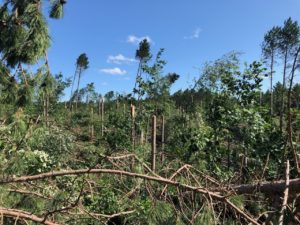Storm Damage
High Winds Damaged My Woods – What should I do?
Recently thousands of Wisconsin woodland owners experienced the devastating effects of extremely high winds. If you are among those affected, we are sorry. We know woodlands are personal places enjoyed for their natural beauty and recreation. The storm was an affront to those values.

The worst and most widespread damage was suffered in Oconto and Langlade Counties. It is really important that all Wisconsin woodland owners, especially those with the greatest losses, realize in most cases some timber value is recoverable through a salvage harvest.
In this article, we want to help woodland owners gain perspective on the degree of wind damage to their woods and assess appropriate next steps.
Here is our 1-2-3 following damaging high winds.
1. Safety First – You, your family, access, and personal property are your first concern.

The storm is over, but danger is still present in many forms. Your first priority is to secure the safety of your family, home, and immediate surroundings. These are some “watch out” situations specifically involving trees and natural debris. Look for safety concerns–beyond the obvious–broken limbs hung up in tree canopies, debris clogged culverts that could lead to flooding and washed out driveways, cracked or compromised trees still at risk of falling, and fallen trees with twisted or bent branches under pressure. Professional tree removal services are trained to safely handle hazard trees and eliminate danger. Your time and energy can be applied to removing the mess after the danger, in all of its forms, has been eliminated.
2. Assessment of your Woods – Gather basic information to understand the extent of damage to your woods.
If you can do so safely, walk your entire property. There is a good chance of falling branches, so be very aware of your surroundings and wear a helmet.
Make a simple map of your woods. Estimate the size and degree of damage for each area using these categories:

Minor Damage Categories:
A. Slight Tree Canopy Damage – Less than 50 percent of tree canopy branches broken.
B. Significant Tree Canopy Damage – More than 50 percent of tree canopy branches broken.
Major Damage Categories:
C. Significant Branch Loss – Large branches torn from main stem within 20 feet of the ground. The main stem of the tree–most economically valuable portion–is intact, which is ideal when facing a salvage harvest.
D. Uprooted or Twisted Tree Trunk – Uprooted lying on the ground or main stem twisted or broken.
E. Bent Tree Trunk – Main stem bent and leaning more than 60 degrees (greater than 45 degree lean). If the main stem of the tree is bent above 10 feet off the ground, there is still a merchantable main stem. If severely bent below 10 feet, it could be a total loss.
F. Broke Tree Trunk with Value – Main stem broken between 10 to 20 feet off the ground. If the main stem is broke above 10 feet, there may still be a salvageable main stem and value captured.
G. Broke Tree Trunk with No Value – Main stem broken within 10 feet off the ground. If the main stem is broke below 10 feet, the main stem may be a total loss, but the top may have value to capture.
3. Make Considerations for a Salvage Harvest – In many cases, storm damaged trees still have economic value.
A salvage harvest can be the best way to capture remaining value. Importantly, time is of the essence, similar to processing wild game before spoilage. Damaged hardwoods, including oak and aspen, will generally remain merchantable for a year, whereas pine should be harvested as soon as possible.

Choose which option fits your situation:
Option A – Take no immediate action – If most of the damage to your woods was categorized as A or B (minor damage), then no action or wait-and-see is appropriate. Category A damage is generally not a problem and trees will recover without issue. Category B damage is wait-and-see with a recommendation to monitor tree status over the next couple of years. If there continues to be decline, a harvest could be considered at that time. If this is your situation, professional forester’s time is probably better spent helping your neighbors with greater damage.
Option B – Consider a salvage harvest and seek professional forester’s opinion – If you have more than 5 acres in Categories C to G, you should seek a professional opinion regarding salvage harvest.
Next Steps:
If you are convinced a salvage harvest is appropriate for you and your property, consider hiring a consulting forester to assist with setting up and/or assisting with a salvage timber harvest. Find a list of consulting foresters for your county here.
If you are still not sure if a salvage harvest is appropriate for you and your property or have general questions, find contact information for your DNR County Forester here.
Additional Resources:
Complete a D.I.Y assessment of your damage and get the help you need by reading After the Storm – A Woodland Owner’s Guide to Recovery
Get references from other landowners who have worked with the forester or logger you are thinking of dealing with. Visit previous logging jobs if possible.
Research logging companies or individual timber buyers by name at the Wisconsin Circuit Court’s Internet access site: https://wcca.wicourts.gov/
Check with the Department of Agriculture, Trade, and Consumer Protection (DATCP). See if they have had any complaints against the individual or company. 1-800-422-7128, https://datcp.wi.gov/
